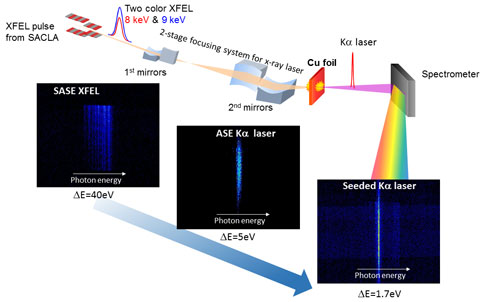| Posted: Sep 14, 2015 |
An atomic laser capable of operating at a wavelength of 0.15 nanometers
(Nanowerk News) The creation of lasers that can generate a coherent stream of X-ray radiation at short wavelengths has long been a goal for scientists. The primary aim of such ‘X-ray lasers’ is to produce high quality, high resolution images of tiny targets, such as molecules. However, the wavelengths of lasers developed to date are still too large to result in clear, detailed images of such targets.
|
|
Now, Hitoki Yoneda and co-workers at the University of Electro-Communications in Tokyo, together with scientists across Japan, have built an atomic X-ray laser with the shortest wavelength yet, producing a stable beam with a wavelength of 1.5 Ångström, or 0.15 nanometers ("Atomic inner-shell laser at 1.5-Ångström wavelength pumped by an X-ray free-electron laser"). This tiny wavelength is nearly ten times shorter than that of previously-reported atomic lasers.
|
 |
| High coherent X-ray Kα laser generated with pump ad seed XFEL pulses. Using copper foil as a medium bombarded by two X-ray pulses of different energies produced by an X-ray free-electron laser, researchers at the University of Electro-Communications in Tokyo have successfully created a powerful and highly coherent atomic X-ray laser with the shortest wavelength to date. (click on image to enlarge)
|
|
Lasers work by using an energy source to excite a laser medium which then release a concentrated stream of photons. This stimulated emission process can increase the coherence of laser light under proper conditions. This work demonstrated that this is true even in the X-ray region.
|
|
The team built their atomic laser based on copper atoms. The researchers exposed the foil to two X-ray pulses of different energies, generated by an X-ray free-electron laser; one pulse was tuned as a pump source and the other as a seed for the main laser beam. Yoneda and his team found that using the pumped copper medium in combination with seeding greatly enhanced the coherence and energy extraction efficiency, short-wavelength beam.
|
|
The researchers hope their ‘hard X-ray inner-shell atomic laser’ will eventually produce ultrastable, high quality X-ray images, and could feasibly transform the fields of medicine, quantum optics and particle physics.
|
|
Background
|
|
The advances in laser technology
|
|
The ability to harness X-rays in an ultra-short, coherent and highly focused way will allow X-ray scientists to image tiny objects – as small as an individual molecule – clearly and precisely. Until now, X-ray lasers have been limited to the larger wavelengths on the margins between UV and X-ray radiation on the electromagnetic spectrum. These larger wavelengths mean the laser beam can bypass smaller molecules without bouncing off them. Existing lasers also produce less detailed images of the target objects as a result.
|
|
Now, the long-standing goal of X-ray science appears to be edging ever closer, with the new ‘hard X-ray inner-shell atomic laser’ developed by Yoneda and his team. The researchers conducted initial tests on a design incorporating a copper foil medium bombarded by one laser pulse from an X-ray free-electron laser acting as a pump for the main laser.
|
|
However, the team were aware of the need to generate as coherent and as high efficiency of extraction as possible, and so decided to incorporate both pumping and seeding X-ray pulses from the X-ray free-electron laser into their design. The resulting X-ray beam is far superior to that of the free-electron laser on its own, with a significantly reduced wavelength of just 1.5 Ångström.
|
|
Future work
|
|
The new laser represents a significant step forward in the future of ultrafast X-ray spectroscopy and X-ray quantum optics. The team hope it will soon be possible to commercialise the product as an high coherent X-ray laser capable of producing high resolution, highly detailed images.
|

